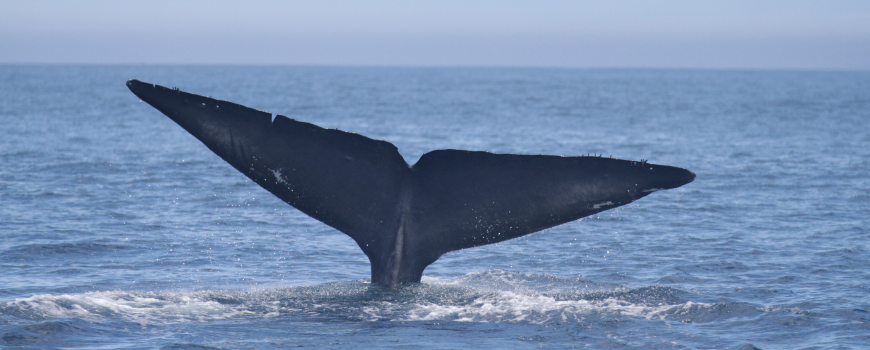Global S&T Development Trend Analysis Platform of Resources and Environment
| Research Highlight: Blue Whales Are Arriving in Southern California Earlier and Earlier | |
| admin | |
| 2020-06-17 | |
| 发布年 | 2020 |
| 语种 | 英语 |
| 国家 | 美国 |
| 领域 | 资源环境 |
| 正文(英文) |  Blue whale fluke. PC: Angela Szesciorka Researchers at Scripps Institution of Oceanography at UC San Diego have found that blue whales migrating to Southern California are arriving sooner than before, and using the previous year’s oceanographic conditions as a driving force. The population of blue whales found off California during the summer months migrate from their winter breeding grounds off Central America. They are a favorite for whale watchers in places like Monterey Bay and the Southern California Bight. While their early arrival is a boon for the whale watching industry, conservation strategies will need to take into account their prolonged time spent in the busy shipping lanes off Southern California, where they are susceptible to ship strikes, noise pollution, and other human-made threats. “We know surprisingly little about the largest animal to ever live,” said Angela Szesciorka, a PhD student at Scripps and lead author of the study, published May 7 in Nature Scientific Reports. “We know they migrate thousands of miles each year to feed on some of the smallest animals – krill. And depending on oceanographic conditions, there may be more or less krill available when whales arrive at their feeding grounds. But, until recently, we did not know what cues blue whales use to time their migration.” Looking at hydrophone recordings, environmental conditions, and krill density from 2008 to 2017, the researchers found that the blue whales were arriving one month earlier by the end of the study timeframe. Specifically, the whales were using the previous year’s sea-surface temperatures as a marker for krill availability the next year. Krill prefer colder water, and sea-surface temperature anomalies which resulted in cooler water attracted more krill, which in turns attracts the whales. The researchers were able to look back on past krill abundance through data collected by the Scripps-based California Cooperative Oceanic Fisheries Investigations. “We were lucky that Scripps has a number of long-term datasets that we were able to combine in a unique and interdisciplinary way to explore blue whale migration timing and the potential effects of climate change,” said Szesciorka. The researchers tracked the whales using acoustic instruments moored to the seafloor in five areas off the coast of Southern California. Blue whales are chatty on the feeding grounds. When they first show up in early spring, they produce “D” calls – a social call associated with feeding. As the year goes on, these calls stop, and the males start to produce “B” calls as part of their courtship songs before they head back to the breeding grounds. By using these two calls, researchers were able to track their arrival and departures in Southern California. “I think we were surprised at how important previous conditions were in driving blue whale migration timing,” said Szesciorka. “Other studies have suggested that blue whales have a spatial memory for krill hotspots, but this tells us that their memory of the past year’s conditions allowed them to predict good and bad krill years and to time their migration accordingly.” Blue whales are classified as endangered by the International Union for Conservation of Nature. After being decimated by commercial whaling, their numbers are rebounding, but they still face environmental and human made threats, particularly in the busy waters off Southern California. “Critical blue whale feeding grounds overlap with high human-use areas, making whales vulnerable to fishing gear entanglements and ship strikes – the leading causes of death for blue whales,” said Szesciorka. “More time at the feeding grounds only increases the risk of these threats. Managers will need to modify their conservation strategies to account for changes in migration timing to reduce these risks.” Co-authors: Lisa Ballance (Oregon State University), Ana Širović (Texas A&M), Ally Rice (Scripps), Mark Ohman (Scripps), John Hildebrand (Scripps), Peter Franks (Scripps) Funding for acoustic data collection came from the U.S. Navy Pacific Fleet Environmental Monitoring Program. Euphausiid database creation supported by NOAA and the National Science Foundation. -Chase Martin |
| URL | 查看原文 |
| 来源平台 | Scripps Institution of Oceanography |
| 文献类型 | 新闻 |
| 条目标识符 | http://119.78.100.173/C666/handle/2XK7JSWQ/276429 |
| 专题 | 资源环境科学 |
| 推荐引用方式 GB/T 7714 | admin. Research Highlight: Blue Whales Are Arriving in Southern California Earlier and Earlier. 2020. |
| 条目包含的文件 | 条目无相关文件。 | |||||
| 个性服务 |
| 推荐该条目 |
| 保存到收藏夹 |
| 查看访问统计 |
| 导出为Endnote文件 |
| 谷歌学术 |
| 谷歌学术中相似的文章 |
| [admin]的文章 |
| 百度学术 |
| 百度学术中相似的文章 |
| [admin]的文章 |
| 必应学术 |
| 必应学术中相似的文章 |
| [admin]的文章 |
| 相关权益政策 |
| 暂无数据 |
| 收藏/分享 |
除非特别说明,本系统中所有内容都受版权保护,并保留所有权利。
修改评论